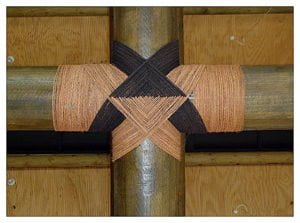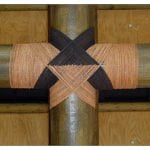The ancient art of lalava is the use of decorative coconut sinnet lashings (Magimagi) in the construction of canoes and houses.
Magimagi is made from coconut husks in black or natural. (The black colour is achieved through soaking in mangrove mud).
The husks are boiled and soaked in water for several days, then pounded and dried in the sun.

The fibres are then spun by rolling on the thigh, and the resulting string is braided.
The art of Lalava was a result of the lack of building supplies (nails and screws).
Magimagi was used in place of nails and screws to connect the beams.
Talitali is the weaving done on horizontal beams.
Lalava is weaving that was done on the vertical beams. Malo/Lairo is the woven design insert.
Lalava is an art form practised only by Kai-Lau- people from Lau islands, the group of Fiji islands closet to Tonga.
The origins of Lalava can be traced back to Tonga.
There are two settlements of Kai-Lau along the Coral Coast.
Jafau, Korolevu and Wesei, a local settlement near Maui Bay






You must be logged in to post a comment.